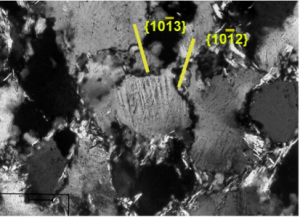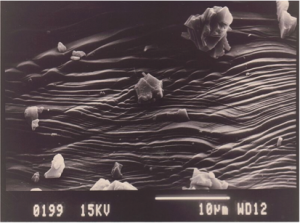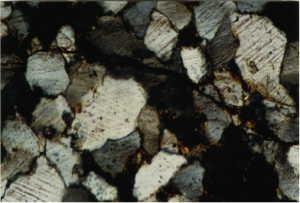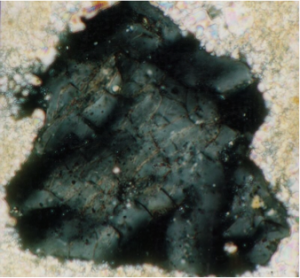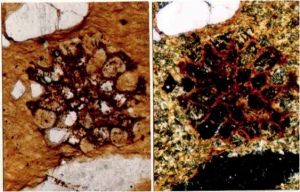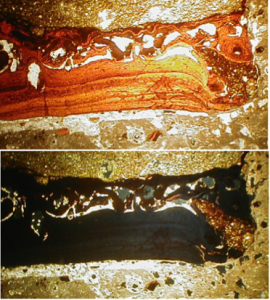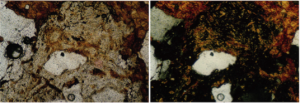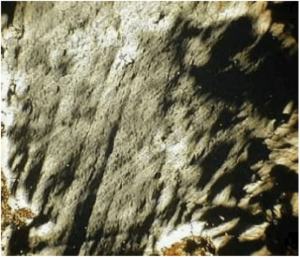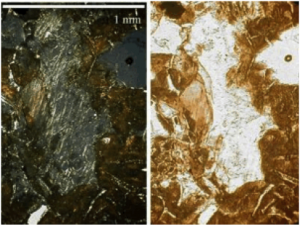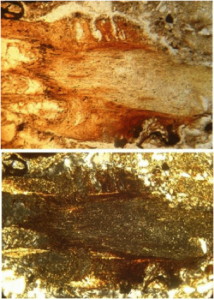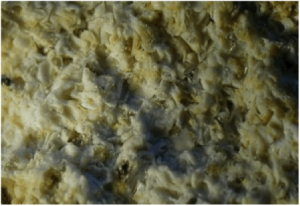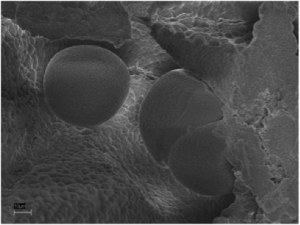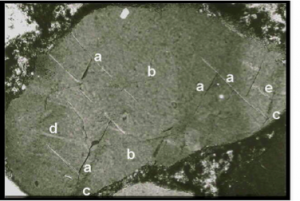“The convincing identification of terrestrial meteorite impact structures: What works, what doesn’t, and why”
by Kord Ernstson & Ferran Claudin (Dec. 2013)
Abstract. – We use and variegate the title of this article published in Earth-Science Reviews to show how science may (mal)function, how scientific results are manipulated, and how a few exposed impact researchers (the authors of the Earth-Science Reviews article included) are counteracting exactly the ideas presented in that article.
1 Introduction
“The convincing identification of terrestrial meteorite impact structures: What works, what doesn’t, and why” is the title of a comprehensive and in principle not too bad article written by Bevan M. French and Christian Koeberl and published in Earth-Science Reviews (French & Koeberl 2010). We however would like to take up this title to once more point to the large Azuara and Rubielos de la Cérida impact structures in Spain and the related controversy shedding light on how science is manipulated, in this case with regard to some impact researchers from the so-called “impact community” (whatever that may be).
2 What doesn’t work
With a slight modification we begin with “what doesn’t work”. As for the identification of meteorite impact structures it obviously doesn’t work to publish clear and generally accepted impact shock features (like they are addressed in that article) to get an impact structure being established. This holds true for both the Azuara and Rubielos de la Cérida impact sites that are still opposed vehemently by a few leading impact researchers. Apart from the manifold geologic and geophysical evidence like ubiquitous monomictic and polymictic breccias, large systems of monomictic and polymictic breccia dikes, enormous and extended megabreccias, shatter cones, extended impact ejecta, gravity and geomagnetic anomalies, the unambiguously established shock metamorphism like shock melt, planar deformation features (PDFs) and diaplectic glass in various minerals appears not to convince (title!) Christian Koeberl, Falko Langenhorst, John Spray and others. Therefore, we once more present a collection of impact shock features from the Azuara and Rubielos de la Cérida impact structures in Spain that have all been published earlier in various journals:
Azuara impact structure: Planar deformation features (PDFs)
Fig. 1 A-D: PDFs in quartz from the Azuara impact structure. A, B: in quartzite rocks from the impact ejecta deposit (Pelarda Fm.). C: from a polymictic strongly shocked breccia. D: Frequency diagram of Azuara PDFs based on data elaborated by Dr. A. Therriault. All figures have been published earlier.
An independent investigation of PDFs in samples from the Azuara impact structure (a polymictic dike breccia and Pelarda Fm. ejecta) was made at the Geological Survey of Canada by Dr. Ann Therriault (Therriault 2000). She analyzed the crystallographical orientation of PDFs in quartz (Fig. 1 D) and other parameters such as density, sharpness, spacing, and spreading over the grain (Fig. 1 C). And we cite from her report: Up to five sets of PDFs per grain were observed. The spacing is 1 µm or less, the PDF density high. Practically all sets are decorated. All shocked grains have reduced birefringence of 0.004 – 0.008.
Azuara impact structure: diaplectic quartz crystals and diaplectic glass
Fig. 2 A, B. Diaplectic quartz crystal and a sandstone fragment completely transferred to diaplectic glass. These examples of strong shock in the Azuara structure have frequently been published earlier.
Azuara impact structure: shock melt
Fig. 3 A, B. Melt glass from a strongly shocked polymictic breccia in the Azuara impact structure. These examples of strong shock in the Azuara structure have frequently been published earlier.
Rubielos de la Cérida impact structure: planar deformation features (PDFs) and diaplectic glass
Fig. 4. Rubielos de la Cérida impact structure: Diaplectic glass and multiple sets of PDFs in quartz. Published earlier.
Fig. 5. Rubielos de la Cérida impact structure: feldspar grain completely transferred to diaplectic glass. Published earlier.
Rubielos de la Cérida: impact shock melt
Fig. 6. Rubielos de la Cérida impact structure: melt glass; suevite from the Barrachina megabreccia. Published earlier.
Fig. 7A, B. Rubielos de la Cérida impact structure: silicate melt rock composed of more than 90% pure glass. Under the optical microscope and the SEM. Published earlier.
Azuara impact structure: Multiple sets of planar fractures (PF)
Fig. 8. Quartz grain from a highly shocked polymictic impact breccia, Azuara impact structure, exhibiting at least four sets of planar fractures. Here we explicitly cite the text in the French & Koeberl article: “Multiple PF sets are definitely the product of impact-generated shock waves; they are developed in the rocks of established impact structures while being absent in the surrounding undeformed country rock “. This image with the Azuara multiple PFs has been published on many occasions, for the first time already in the early paper of Ernstson et al (1985) on Azuara.
The figures shown here are only a very small extract of the host of evidences of clear shock in the Azuara and Rubielos de la Cérida impact structures (also presented here on our impact websites), and we request Langenhorst, Koeberl, Spray and others to directly and straightforward explain why this clear shock evidence matching all impact literature and findings in impact structures all over the world in their opinion is no shock. We ask them to explain why they ignore the sound investigation (the original 31 pages report being at our disposal) of their colleague Dr. Ann Therriault on the Azuara PDFs.
3 What works
With regard to the above presented, on many occasions published clear impact evidence for the large Spanish impact structures, and the reaction of a few exposed impact researchers we clearly see what obviously works: again and again negating, suppressing, disqualifying, manipulating and wrongly or not at all referring to the published Azuara and Rubielos de la Cérida material, and we only mention Langenhorst & Deutsch (1996), Langenhorst (2002), French & Koeberl (2010), and the Canadian Earth Impact Database at the New Brunswick university, managed by John Spray. Of course, this stimulates quite a few other researchers to uncritically adopt this seemingly mainstream “wisdoms”, and in a few cases they even have “an ax to grind” (examples are well documented).
A typical example of what works is the Canadian Impact Data Base. In a written inquiry Ferran Claudin asked John Spray why the Azuara structure formerly established as a proven impact had been eliminated from the database and why also Rubielos de la Cérida despite overwhelming impact evidence has not been recorded. Moreover, Ferran offered to send him reprints of all published articles on the impacts. John Spray wrote back that Ferran were free to do it but that he, John Spray, would not read the articles. And hence the Spanish impact structures are further on being ignored in that database. In more detail we’ve written about this (mal)functioning of science here on our websites (see Earth Impact Database – Database of Earth Impact Structures – Meteorite Craters and Controversy and Azuara shock effects.
To underline the “what works” in manipulating science we explicitly refer to the French & Koeberl article under discussion and how the Spanish impact structures are discredited. French & Koeberl are writing of “recent reports of evidence for impact” and refer to the 1985 (!) very early paper by Ernstson et al. on the Azuara impact. In addition they refer to the Ernstson et al. paper of 2001 that in fact could be termed “recent”. However this is not a report of evidence for the Azuara and Rubielos de la Cérida impacts but a report on special impact features in shocked conglomerates (Ernstson et al. 2001) related to these impact structures. The crucial point in this connection is the fact that the 1985 and 2001 papers are referred to by French & Koeberl, but not the other basic publications of Ernstson & Fiebag (1992), Ernstson & Claudin (1990), Hradil et al. (2001), Claudin et al. (2001), Ernstson et al. (2001 a, b; 2002) on the prominent impacts in Spain. Instead, and this must be termed a masterpiece of manipulating science, French & Koeberl refer to the comprehensive Ernstson et al. (2002) paper on Azuara and Rubielos (summarizing ALL geological, geophysical, mineralogical and shock metamorphism impact evidence) NOT as a proof for impact but solely in relation with the above mentioned conglomerates. Thus, they declare the Azuara and Rubielos de la Cérida impact evidence as non-existent and are speaking of “possible impact structures” and, to cap it all off, writing that “no other, more convincing, evidence of impact has yet been provided for those two Spanish structures.” Once more: a masterpiece of manipulating science.
4 Why
The question why scientists behave like just described for the impact researchers Langenhorst, Koeberl, Spray and others is a long and old story exemplified from all scientific disciplines, and envy, resentment, even malevolence, personal payback, striving for power, and financial aspects (funding) are always found as impetus.
In the special case of the Spanish impact structures we well understand (without approving it) that a few Spanish regional geologists are doing all they can to eliminate the impact structures and the giant Azuara impact event, that considerably changed the younger Tertiary geology of Northern Spain, from the geologic scene. They have worked for decades in the regions of the impacts, they have written big theses on the regional geology, and they are now confronted with a new geology while not understanding impact processes and impact geology (which we have addressed on the Controversy pages).
The case with Koeberl, Langenhorst, Spray and others is different. Although they have obviously never been in Spain to study the fantastic impact scenarios, THEY understand impact, and THEY are well able to read and verify the classic impact and shock evidence for Azuara and Rubielos de la Cérida presented in the many publications. And they probably well understand that the big multiple impacts of the Azuara event are more or less exceptional among the very big terrestrial impact sites with the innumerable and easily accessible highlighting outcrops of impact geology and impact features, not to forget the constellation of an extended crater chain establishing the 80 km long Rubielos de la Cérida impact basin that is unique on earth. And this is the very point: THEY (in their opinion being the impact Big Boys) are NOT involved in the investigation and research of this spectacular impact. And along the lines of “If I can’t have it, then nobody else should have it either“, or “If I can’t have it, then I ruin it for you” the Spanish impact structures are massacred.
5 Conclusions
Although the article by French & Koeberl (2010) presents a useful compilation of impact features, the unmissable manipulation of scientific results already practiced earlier also by Langenhorst & Deutsch (1996) and Langenhorst (2002) and focused on the large Spanish Azuara and Rubielos de la Cérida impact structures does serious harm to research, and it does impact science in general a bad turn – to say the best of it.
French & Koeberl are presenting as unambiguous proof for shock and meteorite impact
— multiple sets of planar fractures in quartz (their figures 11,12 and text on page 134)
— diaplectic glass from various minerals (their text on pages 131, 132)
— planar deformation features with frequency diagrams of crystallographic orientations (their figures 16, 17, 18, 19 and text on pages 136, 137),
and at the same time they ignore exactly these clear shock features in the Spanish impact structures (see our Figs. 1-8). That is they defraud the reader when they are speaking of “possible” Azuara and Rubielos de la Cérida impacts and “no convincing evidence”. Hence, the heap of structures and related references addressed in the French & Koeberl paper should not hide the fact that the article has to be considered with caution and that it is obviously not a solid and reliable reference in impact research, all the more as important impact features like, e.g., impact shock spallation in rocks and minerals are simply missing.
References
Claudin, K., Ernstson, K., Rampino, M.R., and Anguita, F.: Striae, polish, imprints, rotated fractures, and related features in the Puerto Mínguez impact ejecta (NE Spain). Abstracts, 6th ESF IMPACT workshop, Impact Markers in the Stratigraphic record, pp. 15-16, 2001.
Ernstson, K., Rampino, M.R., and Hiltl, M.: Shock-induced spallation in Triassic Buntsandstein conglomerates (Spain): an impact marker in the vicinity of large impacts. Abstracts, 6th ESF IMPACT workshop, Impact Markers in the Stratigraphic record, pp. 25-26, 2001.
Ernstson, K., Claudin, F., Schüssler, U., Anguita, F, and Ernstson, T.: Impact melt rocks, shock metamorphism, and structural features in the Rubielos de la Cérida structure, Spain: evidence of a companion to the Azuara impact structure. Abstracts, 6th ESF IMPACT workshop, Impact Markers in the Stratigraphic record, pp. 23-24, 2001.
Ernstson, K., Rampino, M.R. & Hiltl, M.: Cratered of cobbles in Triassic Buntsandstein conglomerates in NE Spain: Shock deformation of in-situ deposits in the vicinity of large impacts. Geology, v. 29, no.1, 11-14, 2001.
Ernstson, K., Hamman, W., Fiebag, J. & Graup, G.: Evidence of an impact origin for the Azuara structure (Spain). – Earth Planet. Sci. Let., 74, 361-370, 1985.
Ernstson, K. & Claudin, F.: Pelarda Formation (Eastern Iberian Cains, NE Spain): Ejecta of the Azuara impact structure. – N.Jb.Geol.Paläont.Mh., 1990, 581-599, 1990.
Ernstson, K. & Fiebag, J.: The Azuara impact structure (Spain): new insights from geophysical and geological investigations. – Int. J. Earth Sci., 81/2, 403-427, 1992.
French, B.M. & Koeberl, C.: The convincing identification of terrestrial meteorite impact structures: What works, what doesn’t, and why. – Earth-Science Reviews, 98, 123-170, 2010.
Hradil, K., Schüssler, U., and Ernstson, K.: Silicate, phosphate and carbonate melts as indicators for an impact-related high-temperature influence on sedimentary rocks of the Rubielos de la Cérida structure, Spain. Abstracts, 6th ESF IMPACT workshop, Impact Markers in the Stratigraphic record, pp. 49-50, 2001.
Langenhorst, F. : Shock metamorphism of some minerals: Basic introduction and microstructural observations. – Bulletin of the Czech Geological Survey, Vol. 77, No. 4, 265–282, 2002.
Langenhorst & Deutsch (1996): The Azuara and Rubielos structures, Spain: Twin impact craters or Alpine thrust systems? TEM investigations on deformed quartz disprove shock origin (abstract). Lunar and Planetary Science, v. XXVII: 725-726.
Therriault, A. (2000): Report on Azuara, Spain, PDFs, 31 p.







































































